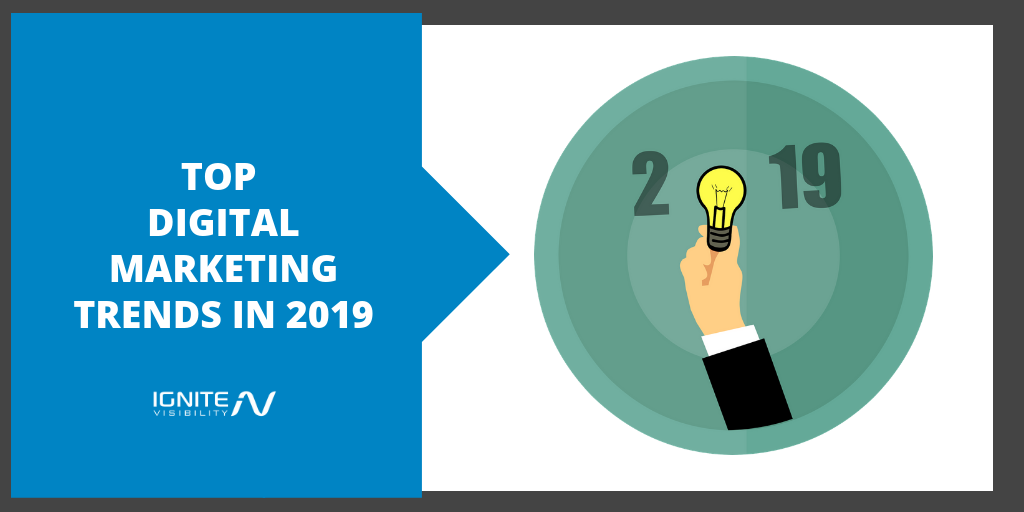There’s been a lot of changes in digital marketing over the past year – which means there’s a lot to look forward to in 2019.
Below, I’ve listed out the new and exciting things you can do with SEO, PPC, social media and more.
Digital Marketing Trends in 2019: SEO
Schema for FAQ
Using Question & Answer schema on any designated FAQ sections gives your content a better shot at making it into Google’s coveted Knowledge Panel.
For those unfamiliar, schema markup is generally used to give search engines some added information about your site and its content, which they can then use to give your site a higher ranking in the SERP.
As searches continue to move towards question form and content types like FAQs increasingly appear as Featured Snippets, this type of Q&A schema is becoming even more important.
AMP Stories and AMP AI
Launched earlier this year, AMP Stories are designed to add Google’s fast-loading AMP technology to visual content rather than traditional text.
Using it, publishers have an easier, faster way to produce visually-immersive content.
But Google’s giving these AMP Stories the AI treatment.
Google explains it like this:
“We’re beginning to use AI to intelligently construct AMP stories and surface this content in Search. We’re starting today with stories about notable people—like celebrities and athletes—providing a glimpse into facts and important moments from their lives in a rich, visual format. This format lets you easily tap to the articles for more information and provides a new way to discover content from the web.”
Voice Activated Searches
With all the advances in the use of voice-activated searches and digital assistants like Google Home and Amazon Echo, it’s extremely important to optimize your site for the types of queries being asked using voice assistant technology.
That means a clear emphasis on conversational language and question and answer, FAQ content blocks.
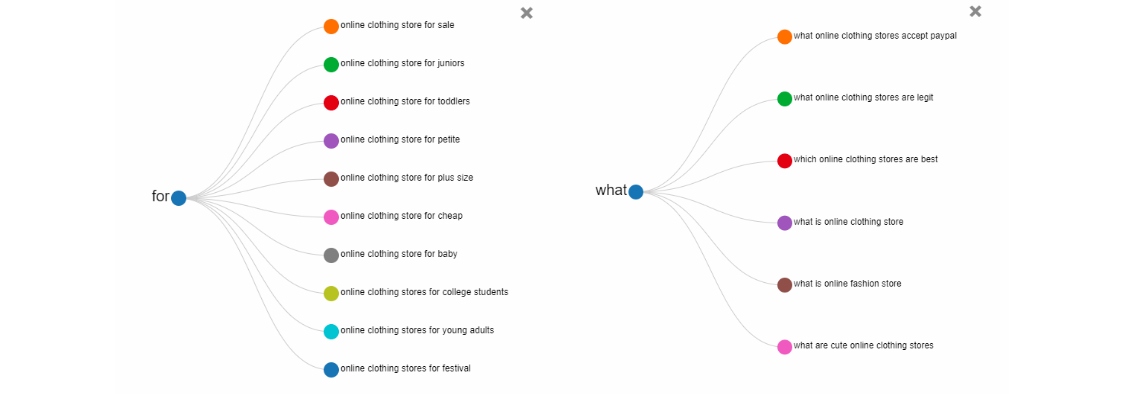
Digital Marketing Trends in 2019: Voice activated search queries
Neural Matching – Digital Marketing Trends in 2019
Google recently revealed that it’s been using neural matching, an AI method used to better connect words to concepts.
Essentially, it means that Google is getting better at matching synonyms and better help users find relevant search results – even if those results don’t match the exact words in the query.
Google’s Danny Sullivan reports that the neural matching algorithm is currently affecting 30% of searches.
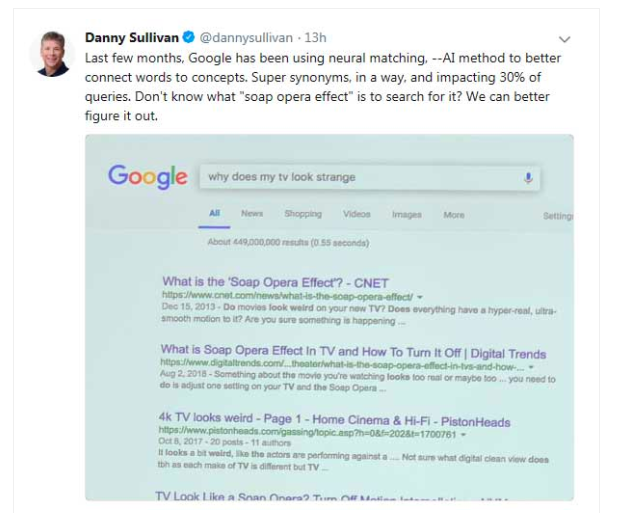
Digital Marketing Trends in 2019: neural matching
Dynamic Search Results
Google’s on a mission to make searching as seamless as possible, even if you don’t exactly what it is you’re searching for.
So it’s new dynamic search results will help searchers determine what to search for next.
For example, if a searcher types “pugs” into the search bar, Google will return possible follow-up searches in a tab at the top of the screen with subtopics like “names,” “how to train,” “health,” etc.
Powered by AI, this new feature will continue to learn and evolve as more related searches are performed, and tab results will be updated accordingly to reflect the most relevant information.
Google Discover
Google Discover is a revamped version of Google Feed, designed to uncover relevant content for each individual searcher.
Like social feeds, it doesn’t necessarily show content based on timing, but rather basis it on the types of content you’ve previously interacted with.
The purpose is to help you find what’s most interesting to you, and a Discover will soon start showing up in search results so Google knows to show you more of that kind of information in the future.
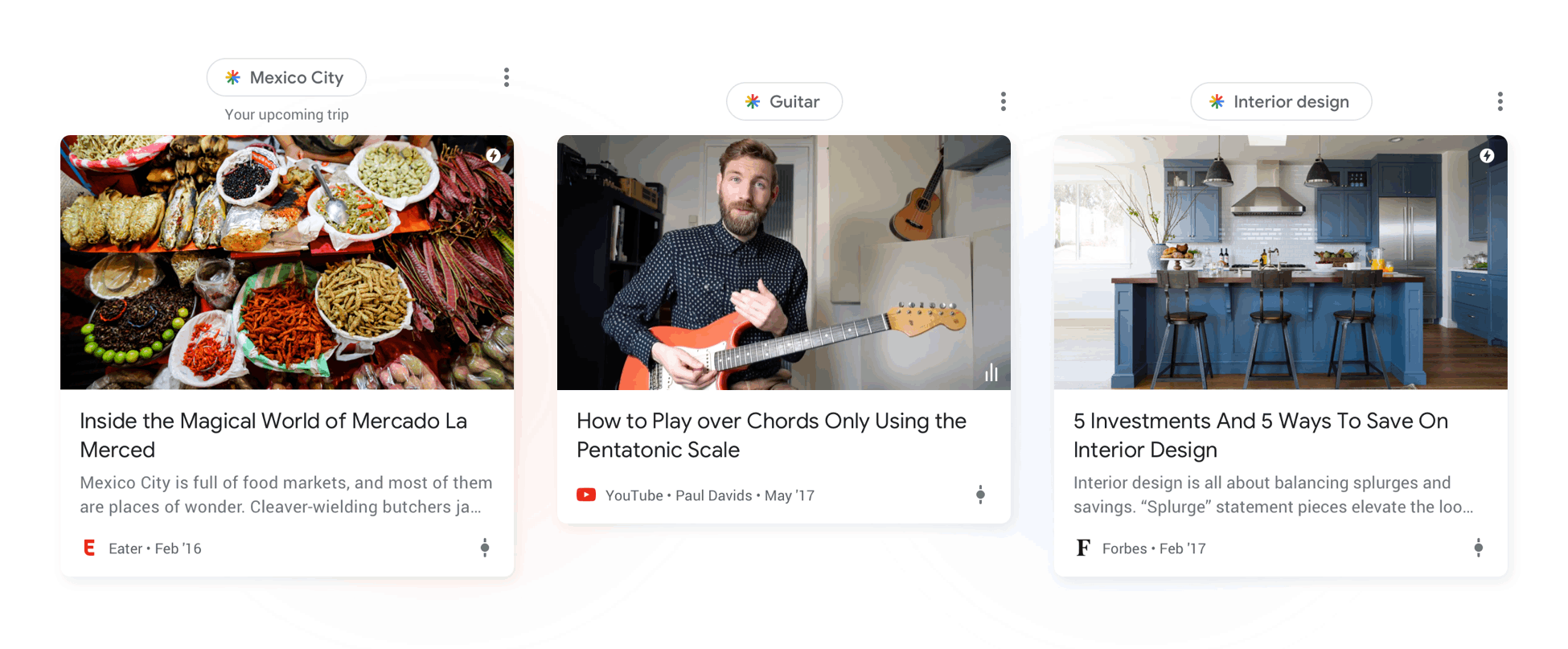
Digital Marketing Trends in 2019: Google Discover
Mobile-First Initiative – Digital Marketing Trends in 2019
Mobile first indexing has rolled out. Mobile users are continually on the rise.
Your site must be mobile-friendly, preferably with a responsive design to adjust to ever-changing technologies.
Google My Business Lets Companies Add Products to Listings
Still in its testing days, this new feature lets businesses add product collections to their listings instead of services.
This is an especially useful addition for businesses that primarily sell products, not services, like e-commerce, etc.
It appears where brands would usually add in their services, and businesses can display the name of the product, a 1,000 character description, the price, and a photo for each product.
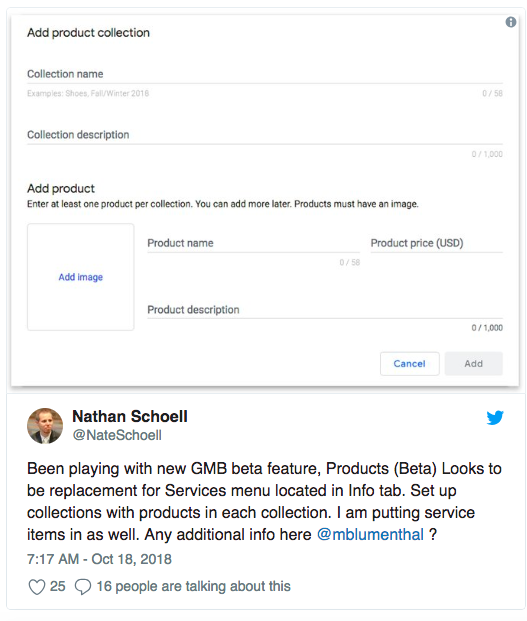
Digital Marketing Trends in 2019: GMB product listings
Google My Business Shows Which Search Queries Bring Up Business
A feature released earlier this year shows Google My Business page owners which queries people are using to find your business.
The feature appears under the Insight tab in your GMB account, and will show the most common search trends terms that bring visitors to your site.
Google Dynamic Rendering
Google recently released its long-awaited documentation on dynamic rendering.
Traditionally, websites run by JavaScript are harder for search engine bots to parse and index since it’s not static code like HTML.
But using dynamic rendering, web developers create a series of static pages that they serve only to bots. That way, search bots can see the content and index it.

Digital Marketing trends in 2019: Dynamic Rendering
Doing so will help ensure these bots can properly parse your content and amplify its reach in the search results to your audience.
Anyone with a site that serves content from JavaScript should be using dynamic rendering.
Expandable Subtopics in Featured Snippets
Google also continues to improve its featured snippet (or rank “0”) position.
Recently, it rolled out a new format that displays additional information about a subject via drop-down menus.
According to Google, the new featured snippets are designed to surface what it thinks to be common and useful aspects of a topic.
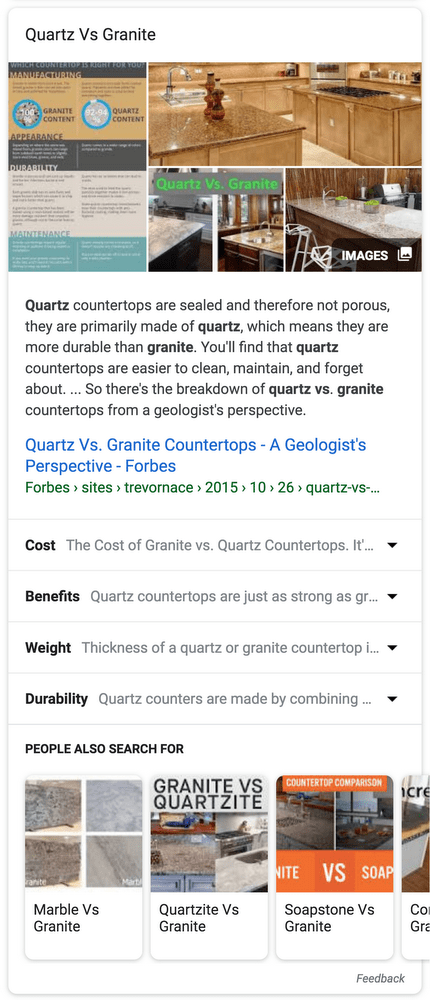
Digital Marketing trends in 2019: Expanded featured snippets
Google Redefines Low-Quality Content
Google made a few edits to its Quality Rater Guidelines, and more specifically to its definition of poor content.
Among the changes, raters should mark a page “low quality” if it meets the following conditions:
- Has a clickbait headline
- They can’t determine the purpose of the page
- The page contains hateful content directed at people based on their political beliefs or socio-economic status
- The page contains harmful links to users
- The page contains “demonstrably inaccurate content”
- The content tries to trick users into clicking links
- The content promotes mental, physical, or emotional harm in any way
Digital Marketing Trends in 2019: PPC
Google AdLingo
Google’s latest addition to the ad scene is AdLingo, a marketing platform that allows advertisers to use their conversational assistants at scale across the Display Network.
Similar to how chatbots work, these assistants are designed to lead users through interactive conversations in real time – without having to click through to the advertiser’s website.
Ad costs will be measured by CPM (cost per impression), and powered by chatbot tools like DialogueFlow, LiveEngage, Blip, etc.
https://youtu.be/z3Zj1NgA4_c
Bing Shopping Ad Features
In April, Bing released a slew of new features to complement its popular shopping ads.
The first was verification via UET (Universal Event Tracking) tags, which help advertisers quickly set up a Bing Merchant Center store. These are necessary if you want to create shopping ads, and the new feature streamlines the process.
Next, Bing introduced new columns in their Product Grids grid to easily access information, including:
- Products Submitted: Total count of products that have been submitted/uploaded to your store.
- Products Ready to Serve: The number of products that have been processed, are error-free, and are eligible to serve if they have a bid associated with them.
- Products Targeted: The number of products that are being bid upon by the product group (excludes all excluded nodes and campaign filters).
- % Products Targeted: The percentage of products based on the total products submitted that are being bid upon in the product group.
Additionally, Bing now lets advertisers upload multiple images to their shopping ads.
Bing Advertisers Get Access to LinkedIn Targeting Data
Microsoft recently announced that advertisers can access and leverage LinkedIn data for search campaigns on the Bing platform.
This new ability has been anticipated since Microsoft bought LinkedIn two years ago, and will enable advertisers to pull data from LinkedIn categories like company, job function, and industry.
Bing Ads Editor Supports In-Market Audiences
Though in-market audiences aren’t new to advertisers, they are new to Bing.
Bing announced in May that it would be releasing the popular targeting feature to all advertisers, which lets advertisers create an audience of people most likely to have higher purchase intent.
Using AI, Bing creates this audience by looking at its user’s browsing history and identifying users who have shown purchase intent signals within certain categories.
Then, advertisers can create ads to be shown specifically to that qualified audience.
In testing, Bing says in-market audience targeting has led to click-through rates up to 28% higher, as well as 48% higher conversion rates.
Google Custom Intent Audiences – Digital Marketing Trends 2019
Custom Intent Audiences are designed to help you build audiences that (likely) intend to buy the types of products or services your business offers in the near future.
These can be manually built or automated by Google.
Experienced advertisers can build their own based on specific keywords and URLs that relate to the goal of their campaign.
Automated audiences are built from existing keywords and audiences and through Google’s machine learning tools.
Custom intent audiences are available for the Display network and YouTube campaigns.
Google Customer Match
The new Customer Match audience type lets you target ads to existing and new customers based on data you’ve collected about them on and offline.
For example, you can upload your list of existing customer emails and Google will match those emails to users on its network.
Then, you can run ads to people who are already on your email list and already have proven engagement with your brand, making them a more qualified audience.
You can also use that information to find new users similar to those on your list.
As of now, you can use Custom Match on the Search network, Shopping ads, Gmail, and YouTube.
Google Smart Shopping Ads – Digital Marketing Trends 2019
Google Smart Shopping ads combine Shopping and display remarketing campaigns.
It works like this: Google combines your existing product feed with its machine learning and shows a variety of ads across networks. It will test different combinations of the images and text you provide and determine which combination gets the best results.
Google will also automate the ad placement and bidding for maximum conversion value depending on your budget.
Google In-Market Audiences
In-Market audiences are a targeting method used to find people with purchase intent.
Google find this by tracking user’s browsing history. Based on how often someone is clicking on product ads, browsing related websites, and researching prices, Google will determine if they are or aren’t “in-market” for your product or service.
Then, you can run ads to that audience (narrowed down by industry).
Google Life Event Targeting
Using Google’s Life Event targeting, advertisers can run ads to people going through significant changes in their lives.
Often, those life events lead to major decisions and purchases – making them an ideal audience to show your ads to if your product or service relates to that event.
Currently, AdWords supports the following life events:
- About to graduate college
- Recently graduated college
- About to move
- Recently moved
- About to get married
- Recently got married

Digital Marketing Trends in 2019: Google Life Event Targeting
Google Shoppable Image Ads
Google’s new Shoppable Image Ads are a new type of ad unit that allow advertisers to display shoppable images on publisher websites.
Like shoppable ads on social media channels, users will easily be able to click on an image to learn more information about specific products within the image.
Google eventually plans to roll these out to Image Search results, though no official timeline has been released.
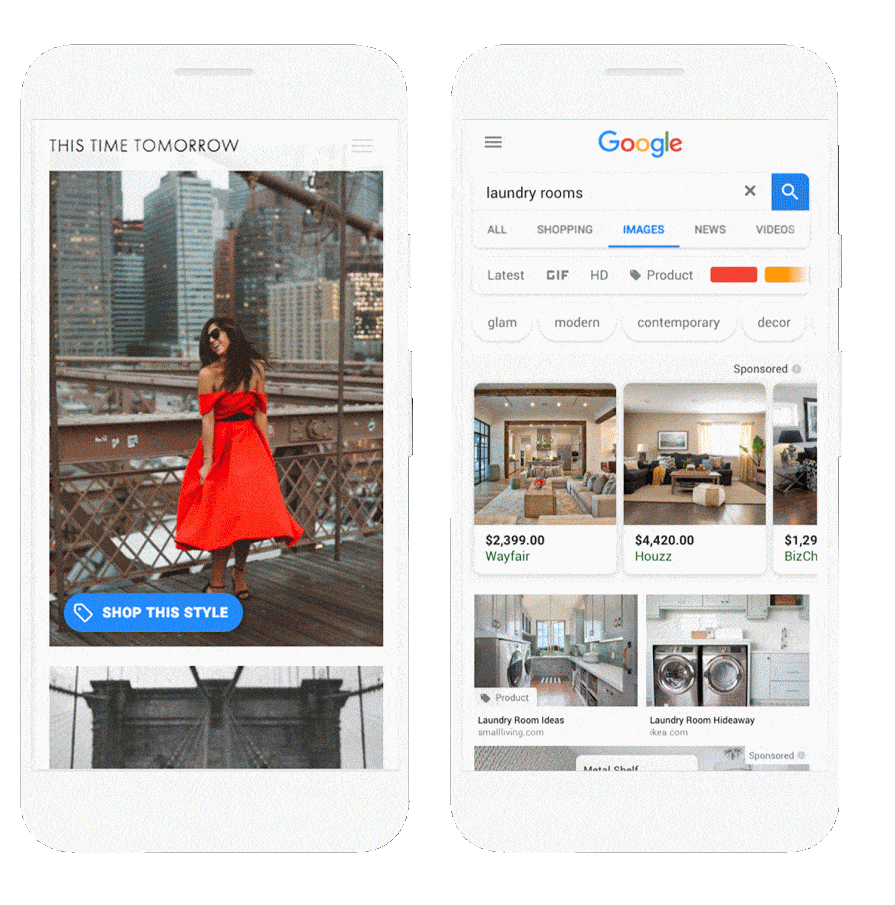
Digital Marketing Trends in 2019: Google Shoppable Image ads
Dynamic Search Ads
Dynamic search ads appear like your regular search ads.
The set-up is where the real difference is: instead of using keywords to filter and target search queries, dynamic ads use content from your website to target customers.
Google matches user’s queries to the content on your website, so when someone searches for something related to a common title or frequently used phrase on your site, Google will show an ad directing that user to the most relevant landing page on your site.
Google Responsive Search Ads
According to Google, responsive search ads “let you create an ad that adapts to show more text—and more relevant messages—to your customers.”
First of all, it means they’ll automatically be formatted to look great across devices – whether it’s desktop, mobile, tablet, laptop, etc.
It also means that you can enter multiple headlines and descriptions when creating an ad, and over time, Google Ads will automatically test different combinations and learn which combinations perform best.
Google Display HTML5 Ads
HTML5 is the latest from HTML and allows developers to write video, animations, and audio into the source code of a page, which eliminates the need for a plugin like flash.
In ad form, Google describes its HTML5 rich media ads as: “Rich media is a digital advertising term for an ad that includes advanced features like video, audio, or other elements that encourage viewers to interact and engage with the content.”
These fit on a page and perform much better than previous forms of banner ads, making them a great way for advertiser’s to create an engaging, unobtrusive ad experience for their users.
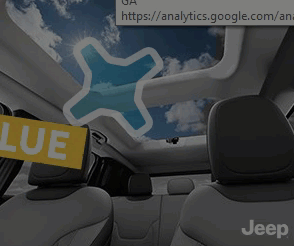
Digital Marketing Trends in 2019: HTML5 ads
YouTube TrueView for Action
TrueView for Action YouTube builds on traditional TrueView campaigns.
They’re designed to help drive leads and conversions by adding prominent CTAs (calls-to-action) and headline text overlays to your video ads, which will then encourage customers to further explore your products or services.
Keep in mind that TrueView for actions campaigns can only run on the in-stream ad format, meaning they play before, during, or after a YouTube video and be skippable after 5 seconds.
YouTube Vertical Video Ads for Mobile
Google recently rolled out vertical video ads for mobile platforms, and ad format that works with both TrueView and Universal App campaigns.
Initially, the ad will cover 75% of the screen. If a user taps on the ad, it will expand to 100%.
According to YouTube, 70% of total watch time happens on mobile devices, and this new format is a way to provide a more seamless ad experience for mobile users.
Digital Marketing Trends in 2019: Social Media
Facebook Stories Ads
Facebook Stories first rolled out in May, and have more recently become available to advertisers everywhere.
Like Instagram Stories ads, which were introduced last year, Facebook Stories ads offer a way to deliver a full-screen, immersive ad to your audience.
These include Facebook’s full targeting and measurement abilities
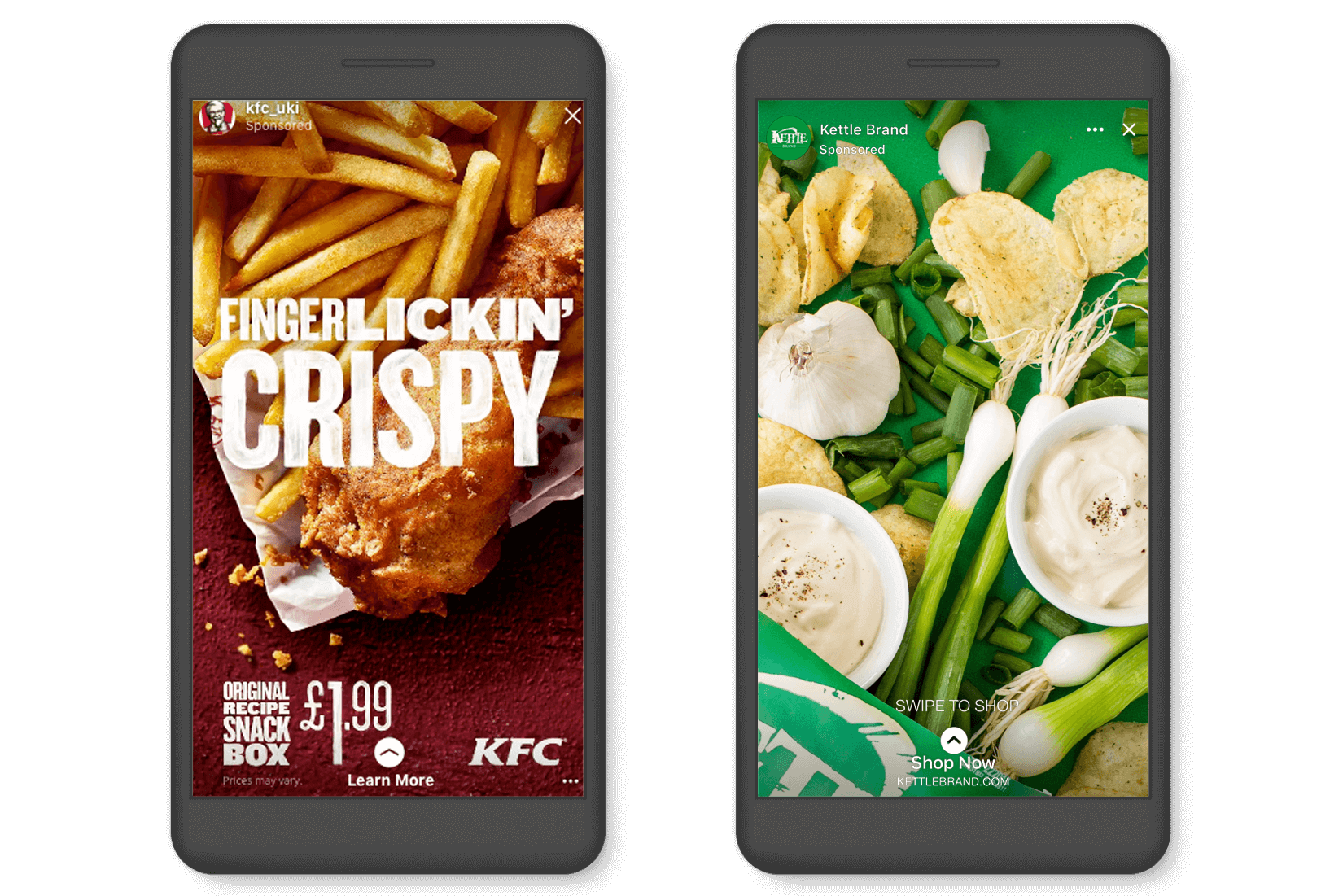
Digital Marketing Trends in 2019: Facebook stories ads
and are expected to come to Facebook Messenger soon.
LinkedIn Integrates Sponsored Content With Google Campaign Manager
This past week, LinkedIn announced that Google Campaign Manager can now track Sponsored Content.
The integration supports a variety of ad formats, including carousel ads, lead-gen forms, video ads, text ads, and “Spotlight” Dynamic ads.
According to the LinkedIn business blog, Sponsored Content support “not only allows you to (1) see LinkedIn ad performance alongside the rest of your paid spend, but also (2) get attribution for your LinkedIn ads across all impressions and interactions, measured in a cross-device and cross-platform manner.”
LinkedIn Dynamic Ads – Digital Marketing Trends 2019
LinkedIn Dynamic Ads allow advertisers to customize their ads based on publicly available information in a user’s profile including their job title, photo, first name, company, etc.
According to LinkedIn, their Dynamic Ads have delivered up to two times the click-through rate of traditional display ads.
These ads are now available to everyone in LinkedIn’s updated Campaign Manager.
Facebook Instant Experiences
Previously called Canvas ads, the revamped Instant Experiences continue to serve ads in a full-screen, immersive form that expands when clicked on.
In the past year alone, the number of Instant Experience campaigns has more than doubled and Instant Experiences are loading faster than ever—now 15X faster than standard mobile websites.
To capitalize on the trend, Facebook’s introduced new templates designed for different business objectives:
- Instant Storefront helps businesses sell products in a grid format.
- Instant Lookbook – enables businesses to display products in the context of a lifestyle image.
- Instant Customer Acquisition – helps businesses drive customer action by displaying offerings and including a clear call to action.
- Instant Storytelling – uses images and video to give people a better feel for your brand.
- Instant Form – lets people easily share their contact information to learn more about your offerings.
Facebook Creative Hub
Facebook’s Creative Hub was created to give advertisers a little need inspiration for their ad campaigns.
It’s a place where advertisers can test new ad formats, preview ads in a mobile format, and share mock-ups of ads with clients before pushing them live.
It also includes a section where advertisers can view examples of similar brands using different creatives and ad formats and getting great results.
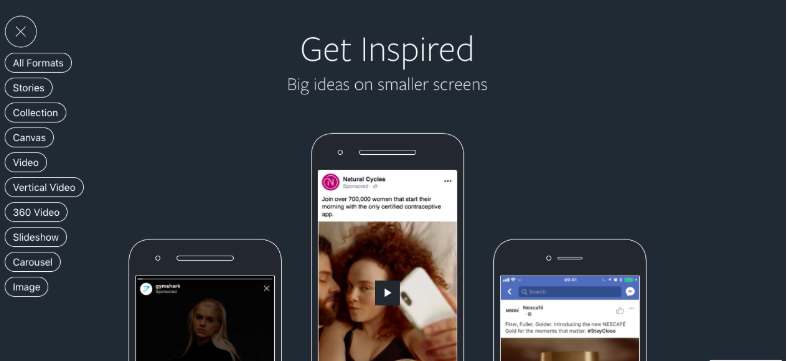
Digital Marketing Trends in 2019: Facebook Creative Hub
Facebook Attribution – Digital Marketing Trends 2019
One of Facebook’s newest additions to its Analytics data set is Facebook Attribution.
Powered by the Facebook Pixel, the tool tracks data for ads on Facebook, Instagram, Audience Network, and Messenger, and enables advertisers to analyze the impact of their advertising campaigns, both on and off of Facebook.
Facebook Attribution offers the following insights:
- Cross-device conversion visualizations
- Conversions from paid, organic, and direct sources
- Conversion and visit metrics segmented by sources
You can find Facebook Attribution in the Business Manager under the “Measure & Report” section of tools.
Facebook Mobile-First Video Creation Toolset
Facebook’s new video toolset enables marketers to more easily create mobile-optimized video ads.
The new tools include:
- Video Creation Kit – translates still images and text into mobile optimized videos. The tool supports both 1:1 and 9:16 aspect ratios.
- Video Cropping Tool – Trims videos to the desired aspect ratio
- Animate Option – Creates a video from a still image
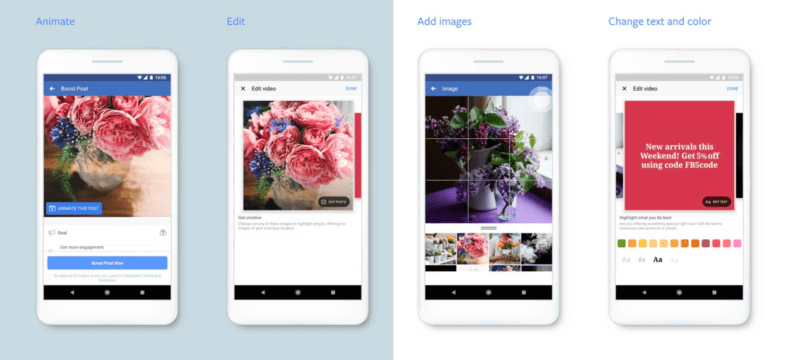
Digital Marketing Trends in 2019: Facebooks mobile first video creation tools
Facebook AR Ads
Facebook started testing a new augmented reality ad back in June that allows users to virtually “try on” different products.
So far, items like sunglasses and makeup have been tested.
To interact with the ad, users simply tap a button. Then, they can place a digital version of the item over their own image.
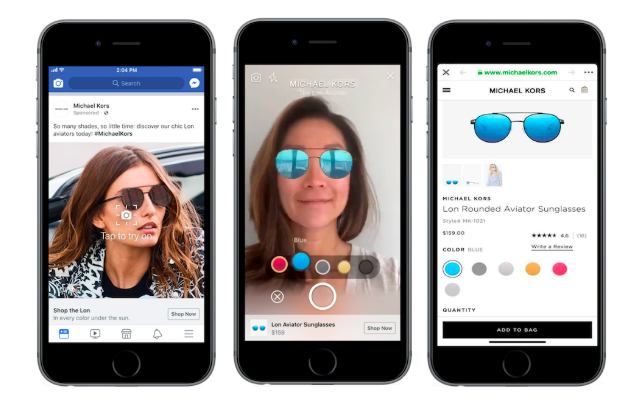
Digital Marketing Trends in 2019: Facebook AR ads
Facebook Adds “Info & Ads” Section
In light of the recent privacy scandals, Facebook is attempting to make its information as transparent as possible.
That includes any and all ads businesses have run on the platform.
Now, every Page has an Info & Ads tab that shows its entire ad history, regardless of targeting options. Users will also have access to more information about Pages, including creation date and any name changes.
Instagram Shopping in Stories
Designed to give people a faster way to shop, Shopping in Stories allows businesses to add product stickers to their Stories to easily add in products.
Approved businesses can add one sticker to a Story. When a shopper taps on the sticker, they’ll be taken to a product details page where they’ll find additional product images, details, similar items, and a link to the brand’s mobile site where they can complete a purchase.
Instagram Shopping in Explore – Digital Marketing Trends 2019
Instagram’s testing a new feature that will help users shop right in the Explore page.
The shopping channel would be fully customized, based on each user’s specific shopping interests.
When they navigate to the shopping section, users would see shopping posts from a variety of businesses that they may like.
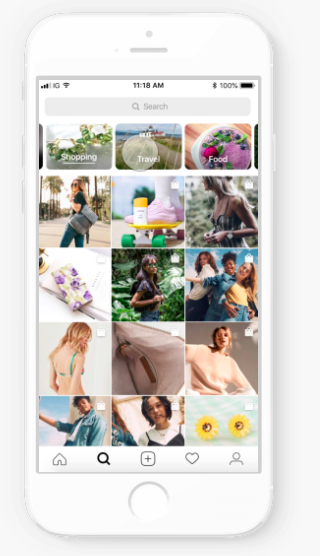
Digital Marketing Trends in 2019: Instagram Shopping in Explore
Promote Feature for Instagram Stories
Instagram recently revealed a new ad type called “Promote” for Stories.
The ad allows businesses pages to easily promote their slideshow Stories users, targeting it to their followers, certain geographic locations, or any one of the large number of Instagram targeting options.
The feature works similar to Facebook boosted posts, essentially allowing marketers to launch an ad with the click of a button.
The feature is currently being tested globally, with no firm timeline for it’s full rollout.
Snapchat Shoppable Snap Ads
The new Shoppable Snap ads allow brands to feature a collection of products within a single ad.
If a user wants to know more about a given product, each image can be tapped on to surface more product details and be taken to an advertiser’s website where they can complete a purchase.
These can run on both the “Discover” page of the app and between Stories.
Pinterest Wide Format Video Ads
Earlier this year, Pinterest rolled out wide-format video ads to all advertisers.
The videos come in both 16:9 and 1:1 aspect ratios, making them 4x bigger than standard ad videos.
During its testing period back in May, analytics showed an increase in both brand awareness and purchase intent among advertisers using the new wide format videos.
Digital Marketing Trends in 2019: Email Marketing
GDPR Compliance
Introduced earlier this year, the GDPR (General Data Protection Regulation) is a new set of rules designed to give users more protection over their information.
And while it affects digital marketing in general, it had a serious effect on email and how you interact with subscribers.
For email marketing, it means:
- All communications must be opt-in (no pre-checked boxes or automatic subscriptions)
- Must clearly explain how customer data will be used during the sign up process, even if you plan to use it for personalization and email segmentation
- You can no longer automatically add contacts to a mailing list
- Customer data must be deleted if requested
- Business must keep a record of consent from users who receive emails
Advanced Personalization and Segmentation
Email segmentation is essentially a way to narrow down your audience into different target groups. You create these segments to better cater to specific groups within your overall audience.
There’s almost no limit to the different ways you segment, but some of the most popular are:
- Geographics (location and related data)
- Demographics (age, gender, social status)
- Psychographics (lifestyle, interests, opinions)
- Behavioral (past purchases, email opens, click-throughs, web pages visited, etc.)
And though it isn’t new, the process of segmenting to better personalize messaging is more important than ever.
In fact, using these practices, many marketers are starting to send less emails, but getting more engagement from the ones they do send.
Mobile Responsiveness for Email
As of now, 61% of email opens happen on a mobile device.
But only 39% of businesses use mobile responsive email templates.
While the majority of emails are still being directed at desktops, adopting a mobile friendly template represents a huge opportunity for marketers to beat the competion and better connect with their audience.
Digital Marketing Trends in 2019
Chatbots and Facebook Messenger Bots
Chatbots aren’t exactly new, but their popularity is only growing.
These bots, generally powered by AI, are usually found on websites or Facebook Messenger, and act similarly to an app.
But with chatbots, users can have a real-time conversation with either a customer service agent or an AI bot.
Designed to automate specific tasks and communicate with customers, you’ll see them used in a variety of situations depending on the industry and goals of the company.
Alexa Skills
Alexa skills is a cloud-based voice service exclusive to Amazon, which lets brands build capabilities in voice form.
You can think of them as the apps of voice search.
Using them, brands can build an experience for their audience powered by voice search. And since their launch 2015, Amazon now has over 30,000 Skills in the US alone.
These represent a lot of opportunities to brands, as they’re still new enough to be novel with your audience and keep on top the growing voice trend.
Keep in mind that those most successful will build Skills based on educating and providing solutions to their audience, not on product pushing or sales.
Google Actions
Like Alexa Skills, Google Actions are voice-powered apps that work specifically with the Google Assitant.
Actions support a specific function and interact one-on-one with users via voice. They’re powered by AI, which means they learn over time and get smarter as they continue to converse with users.
Brands who have had success with apps or chatbots will likely do well with Actions, though it’s important that each Action supports a clear purpose that taps into a purpose or need of their target audience.
Emphasis on AI and Images
Google’s working hard to provide image results as accurate as those it returns in text search results.
With its new AI technology, Google can better understand the context of videos and images and what they represent. So if you publish a video about a national park, Google will know what landmarks, notable people or places are featured in the video, and be able to surface that video in more relevant searches.
Additionally, Google is taking a deeper look at images and the websites they come from.
It’s prioritizing sites with easy-to-find images and has reconfigured its algorithm to rank results that have both great images and content on the page, which means marketers will have to work harder to ensure their images accurately represent their brand.
Wrapping Up Digital Marketing in 2019
And there you have it – the latest and greatest in digital marketing trends for 2019.
How will you be using the above in your strategy?
